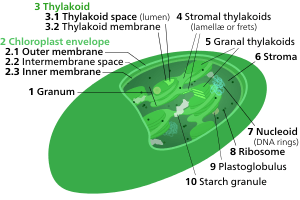Stroma (fluid)
| Cell biology | |
|---|---|
| The chloroplast | |
 Components of a typical chloroplast
1 Granum
4 Stromal thylakoid |
Stroma, in botany, refers to the colourless fluid surrounding the grana within the chloroplast.[1]
Within the stroma are grana, stacks of thylakoids, the sub-organelles, where photosynthesis is commenced [2] before the chemical changes are completed in the stroma.[3]
Photosynthesis occurs in two stages. In the first stage, light-dependent reactions capture the energy of light and use it to make the energy-storage molecules ATP and NADPH. During the second stage, the light-independent reactions use these products to capture and reduce carbon dioxide.
The series of biochemical redox reactions which take place in the stroma are collectively called the Calvin cycle or light-independent reactions. There are three phases: carbon fixation, reduction reactions, and ribulose 1,5-bisphosphate (RuBP) regeneration.
The stroma is also the location of chloroplast DNA and chloroplast ribosomes, and thus also the location of molecular processes including chloroplast DNA replication, and transcription/translation of some chloroplast proteins.
References
- ↑ stroma, n. Second edition, 1989; online version June 2011. <http://www.oed.com/view/Entry/191772>; accessed 12 August 2011
- ↑ Campbell, Neil A.; Brad Williamson; Robin J. Heyden (2006). Biology: Exploring Life. Boston, Massachusetts: Pearson Prentice Hall. ISBN 978-0-13-250882-7.
- ↑ Kramer & Scott Cell Concept iv. 80 1979